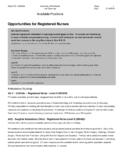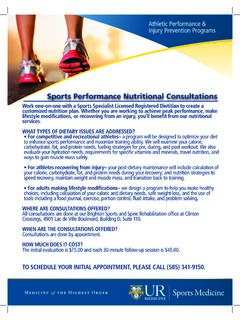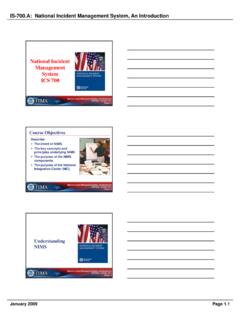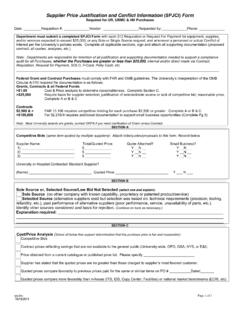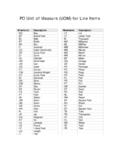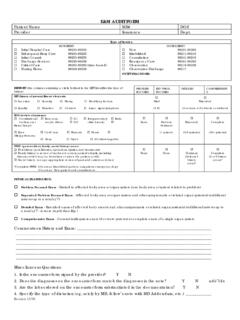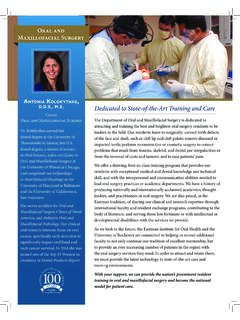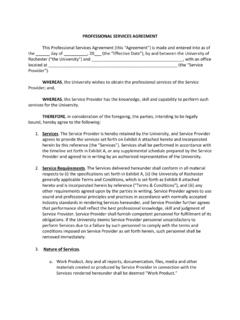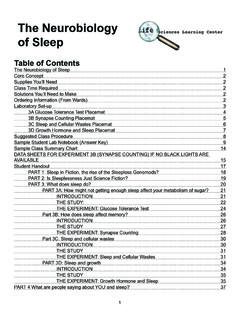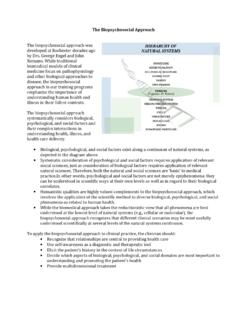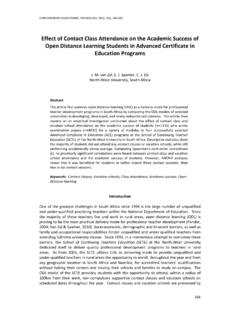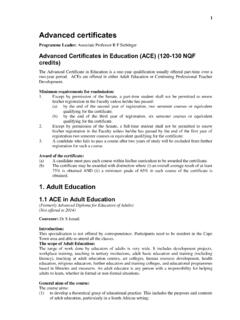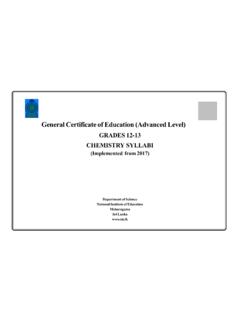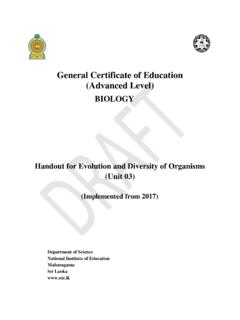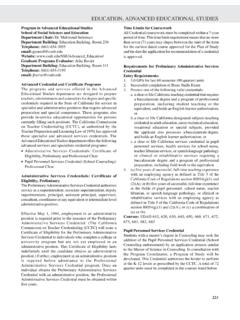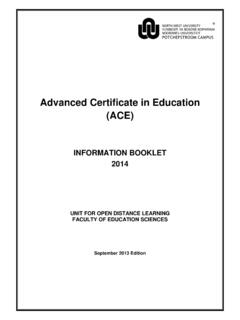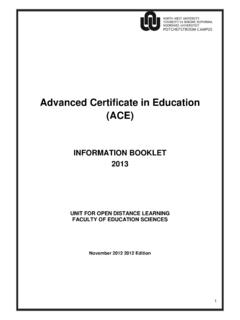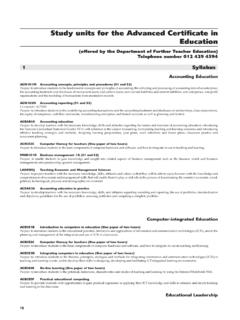Transcription of Clinical/Medical Laboratory Technology Advanced ...
1 SCHOOL OF MEDICINE & DENTISTRY DEPARTMENT OF PATHOLOGY AND Laboratory MEDICINE STRONG MEMORIAL HOSPITAL Program Handbook University of Rochester Medical Center Clinical/Medical Laboratory Technology Advanced certificate Program Page 2- Student Handbook Version-2:vlr Department of Pathology and Laboratory Medicine PROGRAM HANDBOOK I. THE INSTITUTION The University of Rochester, founded in 1850, has developed into one of the country s leading private research universities, classified as a doctoral university highest research activity. The University is a small but highly complex institution composed of six schools: the College of Arts, Sciences, and Engineering, the Margaret Warner Graduate School of education and Human Development, the William E. Simon Business School, the Eastman School of Music, the School of Medicine and Dentistry (SMD), and the School of Nursing as well as a number of world-class facilities such as the Laboratory for Laser Energetics, the Mees Observatory, and the Memorial Art Gallery, which support the University s educational, research, and service agendas.
2 The University has enjoyed continuous accreditation by the Middle States Commission on Higher education since 1921, and was last re-affirmed in 2014. In addition to University-wide accreditation, each professional school regularly undergoes its own specialized review and accreditation. The University currently enrolls approximately 6,100 undergraduate students and 3,450 full-time and part-time graduate students, and has 1,261 full-time tenure-track faculty. The Advanced certificate Program in Clinical/Medical Laboratory Technology operates within the University of Rochester Medical Center (URMC). URMC is part of the University of Rochester and includes the operation of the School of Medicine and Dentistry, Strong Memorial Hospital, Golisano Children s Hospital at Strong, and Eastman Dental Center. With staff and affiliates numbering over 30,000 the University has become the Rochester area s single largest employer.
3 The School of Medicine and Dentistry offers graduate level programs, including: medical doctorates; residency programs; fellowships; programs; master s degree programs; and Advanced certificate programs. Graduate education is a division within the School of Medicine and Dentistry and is responsible for overseeing the following processes within the program: applications, admissions, enrollment, course registration, records retention, tuition remittance, student services and graduation. Strong Memorial Hospital (SMH) accommodates 830 acute care inpatients and has over 39,000 annual admissions. In addition to routine care, SMH also specializes in: organ transplant, trauma and burn care, neonatal intensive care, comprehensive neuro-medicine, complex cardiology and cancer services. The Department of Pathology and Laboratory Medicine (also referred to as UR Medicine Labs) is a division of URMC that provides clinical Laboratory services to Strong Memorial Hospital and its affiliates.
4 UR Medicine Labs is the largest medical Laboratory in the region with 950 members including but not limited to: 56 pathologists, 320 licensed Laboratory professionals, and over 300 employees in pre-analytic operations. The department encompasses: 28 clinical laboratories, 16 research laboratories, 5 satellite laboratories for the Wilmot Cancer Center, a Pathology Residency Program and a PhD program in Pathology. In 2017 the department analyzed over million clinical samples. UR Medicine Labs provides the personnel, faculty, lecture space, clinical training space, support personnel, finances, Laboratory equipment, tools, and supplies necessary to support the program mission. Each entity at the University of Rochester fulfills a critical role and all work together to ensure the successfulness of the Advanced certificate Program in Clinical/Medical Laboratory Technology . II. ABOUT THE PROGRAM Faculty instructors are personnel from the Department of Pathology and Laboratory Medicine, including: associate and assistant professors of the School of Medicine and Dentistry, administrative directors, clinical Laboratory supervisors, and appropriately licensed and certified Laboratory Page 3- Student Handbook Version-2:vlr Department of Pathology and Laboratory Medicine technologists.
5 In addition numerous administrative support personnel assist the program director and faculty with associated program functions including processing financial requests, record retention, creation of recruitment material, entering program materials into learning management systems, scheduling meetings, transcribing outcome data, etc. The program website is found here: III. PROGRAM DETAILS The program is designed to provide graduates with the entry level competencies required to succeed in the Clinical Laboratory . Students gain understandings of clinical Laboratory science by correlating diagnostic findings with diagnosis, prognosis, and disease management of patients in the clinical setting. Students grasp in depth concepts in the following core areas: clinical chemistry, clinical hematology and hemostasis, immunohematology, microbiology, and urinalysis and body fluids. Graduates must pass the American Society of Clinical Pathology Board examination and achieve a state license to practice the profession of Clinical Laboratory Technology in the state of New York State.
6 LENGTH: 2 semesters/ credits FALL SEMESTER SCHEDULE: 18 weeks of instruction beginning the third full week in August through the end of the third full week in December. Thanksgiving Day and the following Friday are vacation days. SPRING SEMESTER SCHEDULE: 18 weeks of instruction beginning the first full week in January with a week of vacation during spring break. Commencement is on the last week of the semester. CONTACT: Vicki Roberts, Program Director and Manager of education , Department of Pathology and Laboratory Medicine, 601 Elmwood Avenue, Box 626, Rochester, NY 14642 IV. PROGRAM MISSION AND GOALS Our Mission-The Advanced certificate Program in Clinical/Medical Technology at the University of Rochester strives to educate future clinical Laboratory technologists who are committed, dedicated, skilled and innovative in their work. We seek to achieve this goal by utilizing educational experiences that emphasize patient care in the cultivation of excellence, competency, teamwork, and integrity in all aspects of Laboratory science.
7 Program Goals-Upon completing the Advanced certificate Program in Clinical/Medical Laboratory Technology , graduates will: a. Have knowledge of and adhere to institutional, regional, national and international safety regulations in the clinical Laboratory setting. b. Achieve the full range of competencies as entry level clinical Laboratory technologists in the following domains: clinical chemistry; hematology/hemostasis, urinalysis, & body fluids; immunohematology/transfusion medicine; immunology; microbiology; and Laboratory management & operations. Page 4- Student Handbook Version-2:vlr Department of Pathology and Laboratory Medicine c. Accurately correlate Laboratory findings to the diagnosis, prognosis, and disease management in the clinical and/or research setting. d. Effectively troubleshoot outcomes that do not conform to prescribed protocols or outcomes. e. Demonstrate leadership capabilities.
8 Have knowledge of the basic principles of management, education , regulatory oversight, quality management, continuous process improvement, and operations in the clinical Laboratory setting. f. Meet the licensure requirements in practice of Clinical Laboratory Technology in the state of New York. g. Be eligible for certification by the ASCP as Medical Laboratory Scientists (when the program has reached serious applicant status in the NAACLS accreditation process). V. COURSE DESCRIPTIONS CMT 401: ESSENTIALS OF CLINICAL Laboratory SCIENCE (3 cr.) Fall Semester This course is offered in the first 5 weeks of the program beginning in the Fall semester and the schedule is Monday through Friday; 8:30am-4pm. The learning model is wrap around lecture followed by hands on Laboratory experiences. The total number of hours including lecture and lab experiences is 150. In class didactic contact time is hours. The methods used are largely student centered Laboratory exercises designed to prepare students for the clinical practicum.
9 Didactic time is limited to the practical knowledge required for students to competently engage in Laboratory activities. a. Overview: Orientation-Program Overview; Review of Student Handbook and Policies: day Clinical Laboratory Safety; Infection Control; Universal Precautions; Ethics and Data Integrity: day Pre-analytic Techniques and Patient Safety Goals: day Phlebotomy: day b. Basic Laboratory Techniques in the content areas listed below (with approximate number of days spent on each subject indicated). Clinical Chemistry: 5 days Clinical Hematology: 5 days Immunohematology and Transfusion Medicine: 5 days Clinical Microbiology & Serologic Techniques: 6 days Renal Physiology and Urinalysis: 2 days CMT 402: CLINICAL PRACTICUM I (7 cr.) Fall Semester This clinical practicum is 325 hours in the fall semester beginning immediately after the 4 weeks of CMT 401 are completed. (The lectures for the non-clinical courses are offered 8-10 hours per week outside of this course.)
10 The schedule will be available before course registration begins. This course is entirely composed of supervised clinical experiences scheduled in the following disciplines: Blood Bank and Transfusion Medicine, Clinical Chemistry, Clinical Hematology & Hemostasis, Clinical Microbiology, Urinalysis, Immunology/Serology, Histopathology, Phlebotomy, and Laboratory Management and Operations. Didactic time is limited to the practical knowledge required for students to meet targeted learning outcomes and to achieve competency in the clinical Laboratory procedures and protocols as assigned. Students are supervised throughout these experiences by a NYS Licensed Clinical Laboratory Technologist. CMT 403: CLINICAL PRACTICUM II ( cr.) Spring Semester Page 5- Student Handbook Version-2:vlr Department of Pathology and Laboratory Medicine This clinical practicum is 425 hours in the spring semester. (The lectures for the non-clinical courses are offered 8-10 hours per week outside of this course.)
